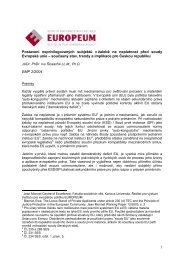eu constitutionalisation - EUROPEUM Institute for European Policy
eu constitutionalisation - EUROPEUM Institute for European Policy
eu constitutionalisation - EUROPEUM Institute for European Policy
Create successful ePaper yourself
Turn your PDF publications into a flip-book with our unique Google optimized e-Paper software.
Chapter 4: Government Coalitions and Institutional Re<strong>for</strong>m at the IGCThe coalitions based on ideological/party-political bases will have a broadissue agenda (agreeing on the issues that are covered by the shared ideology),and may there<strong>for</strong>e change with changes of governments.⁴⁷ Whereasattitudes to the future of <strong>European</strong> integration may alter as governmentschange, the principles linked to the size of populations are clearly not.Hence, in terms of the size of the countries, we should in principle seerather stable coalitions over time. These coalitions also do not necessarilyshare party political affiliations.The culturally-based explanation of collective-<strong>for</strong>mation highlights theimportance of cultural affinity in terms of similar language, history, andgeneral cultural characteristics that in most cases may be the result ofgeographical proximity.⁴⁸ <strong>European</strong> Studies literature refers extensivelyto patterns of long-term relationships within the EU which are basedon long-term strategic interests and/or cultural affinity. In particular,the focus has been on the prominent Franco-German relationship, theBenelux group, and Nordic cooperation, but also other groupings typical<strong>for</strong> specific policy areas.⁴⁹ The basis of these coalitional arrangementsis long-term common interests. This does not mean that the countrieswithin the collective always vote homogeneously, but that they votesimilarly on certain issues.⁵⁰ Most of the long-term partnerships tend alsoto share geographical proximity and hence cultural affinity. The argumentis that the necessary trust <strong>for</strong> a collective endeavour is easier to buildup if the countries are culturally (and usually geographically) closer. Insuch cases, it is plausible to believe that the costs in terms of the timeand resources devoted to establishing and maintaining relationships orestablishing a reputation of being reliable and trustworthy are lower.⁵¹This explanation predicts that the coalitions will have a broader agenda,and are likely to be long-term and <strong>for</strong>malised (given the established trustand long-term relationships).47) Kaeding and Selck (2005).48) Elgström et al (2001): 120; Kaeding and Selck (2005): 275.49) Closa (1995); Morgan and Bray (1986); Pedersen (1998); Pijpers (2000); Wood (ed.) (1995).50) Elgström et al (2001): 118.51) Ostrom (1999): 44-45.Chapter 4: Government Coalitions and Institutional Re<strong>for</strong>m at the IGCFigure 1:The key rationalist and constructivist explanations of coalition-<strong>for</strong>mationRationalismPower-based Interest-based Ideology-based(party-political affiliation)Coalitions will<strong>for</strong>m with oraround the mostpowerful actors.Coalitions willbe issue-specificand short-term.Coalitions will havea broad agenda based onideological and/or partypolitical affinity.Changes to coalitionalpatterns may take placeif governments change.ConstructivismCulture-based(geographical proximity)Coalitions will be stableover time and the samecoalition patterns willoccur in different issuesareas.Characteristics of coalitions and typologyThe different explanations above have already indicated that different typesof coalitions may exist. The most frequent parameters and correspondingtypes of coalitions in EU studies are the following: (i) permanence (ad hocand long-term); (ii) scope of the cooperation (issue-specific and widelybased);and (iii) depth of cooperation (<strong>for</strong>mal and in<strong>for</strong>mal).⁵² Whereasthe rest of the parameters are rather straight<strong>for</strong>ward, the one regardingthe ‘depth of cooperation’ needs a few words of explanations. Najamoffers a number of criteria as to how to determine the depth of cooperation,i.e. the ‘<strong>for</strong>mality’ of coalition:⁵³ a) the existence of written statutorydocuments with defined decision procedures (such as code of conduct ora treaty), i.e. ‘how does the group maintain and display its unity?’; b) theexistence of a <strong>for</strong>mal structure defining different functions in the collectiveand corresponding roles (such as the presidency or the chair); c) theregularity and <strong>for</strong>mality of meetings and in<strong>for</strong>mation exchange, and d) theexpectations of joint public statements and communiqués.Combining a number of the parameters, we can develop a taxonomy ofthe strategic and tactical coalitions that appears to be particularly relevant tothe present study.⁵⁴ Tactical coalitions are present-oriented. The shared52) DuPont (1994); Hayes-Renshaw and Wallace (1997): 251.53) Najam (2001): 80-81.54) This taxonomy is taken from Hayes-Renshaw and H. Wallace, who mention tactical and strategic coalitions,but do not define them. Hayes-Renshaw and Wallace (1997): 251.112113








